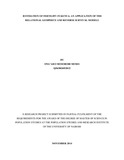| dc.description.abstract | Fertility in Kenya has been declining since 1980s. However, this decline experienced a stall
during the period 2000-2007. The objective of this study was to determine levels and trends of
fertility in Kenya. Specifically, this study sought to determine; levels and trends of fertility in
Kenya, levels of fertility by region and fertility level by place of residence and education level.
The study utilized 2009 census data.
To achieve the above objectives, the study utilized the relational gompertz and reverse survival
models in estimating Kenyan fertility. Data quality was assessed by use of graphs, Whipples and
Myers indices which indicated that the data was of poor quality and needed adjustment before
use. This was done using 5 point method, 3 point moving average and El badry correction.
Estimates from the Relational gompertz model revealed that fertility in Kenya was 4.8 children
per woman if the observed Age specific fertility rates applied until the end of child bearing
period (15-49 years). The results also revealed that fertility had reduced in every province except
Northeastern where fertility increased from 6.5 to 8.0 children per woman. Central province had
experienced the utmost decline from 5.5 to 4.0 in 1999 and 2009 censuses respectively. The
findings also revealed that women with secondary and above level of education had higher
fertility compared to those with none with a TFR of 7.0, 5.8 and 3.9 for never attended school,
primary and secondary and above respectively. Women living in rural areas had higher fertility
compared to their urban counterparts with a TFR of 6.0 and 4.1 respectively. Estimates of TFR
from the Reverse survival method revealed that fertility in Kenya was 4.3 children per woman
with a stall in fertility decline during the period 200-2007 with a TFR of 4.9 children per woman
in the reproductive age (15-49).
Based on the findings of this study, women with no education were found to have the highest
TFR (7.0), there is therefore, need to increase the proportion of women with secondary and
above education in Kenya as this will greatly reduce the level of fertility in Kenya. Although
reverse survival estimates were consistent, the method tends to underestimate fertility levels, to
improve the results; this study recommends that future studies should consider constructing life
tables to be used as the standard because they will reflect better levels of mortality compared to
the standard life tables used in this study. | en_US |

